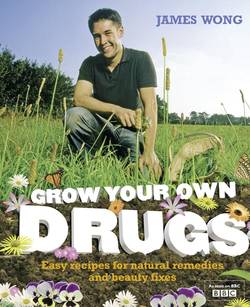Читать книгу Grow Your Own Drugs: A Year With James Wong - James Wong - Страница 4
Оглавление1 THE LIFE OF AN ETHNOBOTANIST!
‘Ethnobotanist’ might not be the catchiest of job titles, and is guaranteed to incite confused looks on immigration forms, but though it sounds techy it describes what is – in my admittedly biased opinion – the most exciting, rewarding job in the world.
Once you start thinking about plants as solutions to problems in life, not just as a colourful backdrop to it, then even the dullest supermarket car park, council roundabout or urban front garden is transformed into a repository of fascinating chemicals, with direct genetic links to peoples and far-flung lands all over the world. And the best thing about it is that everyone can take part, simply by sprinkling a couple of seeds in a pot, raiding the local hedgerows or even foraging the shelves of the local supermarket.
Whether we know it or not, we rely on plants to provide almost everything around us: the food we eat, the clothes we wear, the medicines we take and – without sounding too eco about it – the very air we breathe. A leaflet from the Eden Project has a wonderful way of putting this: every material thing that is not mined, it says, is grown, a point that makes the relevance of plants to everyday life suddenly very clear. How exciting, how adventurous it is to discover for the first time the great impact plants have on us all. With so many of the big questions in life now answered, the wildernesses mapped and the mysteries solved, the amazing, undiscovered uses of plants seem to me to be one of the last great fields of exploration. Even after centuries of study, we still don’t know exactly how many plant species exist, and with the best estimates hovering at over 300,000, there is no end to the potential for them to shock, surprise and delight us.
There is a tendency to think that the use of plants for medical purposes is something from history, making for an interesting anecdote rather than cutting-edge science. The reality could not be further from the truth. The world’s largest and most lucrative pharmaceuticals market is the United States, where 70% of new medicinal drugs have been developed from natural sources. It is clear that we as a species are as reliant on the world of plants as we have ever been: plants are being used to create space-age plastics, ozone-saving biofuels, living pumps for drawing toxins out of soils contaminated by industry, and even giant underwater islands of seaweed to protect tropical coasts from tsunamis. Far from being over, our relationship with plants has only just begun.
And here’s the great news: to take part in the revolution, all you need is a bit of earth, a pack of seeds and a tiny bit of know-how. You don’t even need a garden: the concoctions won’t mind where you source your ingredients. The backyards of friends and neighbours are my favourite source for botanical raw material; you’ll be surprised how generous people will be when promised a jar of sticky sweet winter tonic or fragrant body scrubs in return for a few leaves and twigs. Newbies need not worry too much, either: simply follow a few hard and fast rules and make sure you know what you are picking and how to use it.
In this book, I hope to provide you with a complete tool kit that will get you off to a great start. Before you know it, you’ll be tinkering away like a botanical Willy Wonka, mixing, matching and creating all manner of homespun goodies from the plants growing all around you.
Good luck – and have fun!
